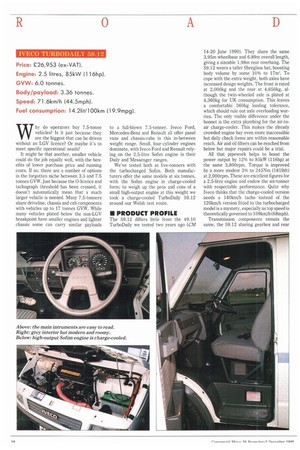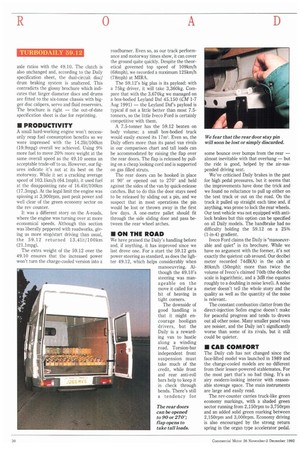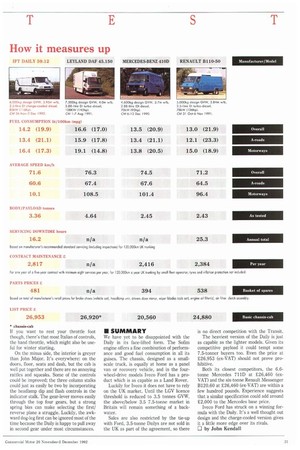W hy do operators buy 7.5-tonne vehicles? Is it just because
Page 30

Page 32

Page 33

If you've noticed an error in this article please click here to report it so we can fix it.
they are the biggest that can be driven without an LGV licence? Or maybe it's to meet specific operational needs?
It might be that another, smaller vehicle could do the job equally well, with the benefits of lower purchase price and running costs. If so, there are a number of options in the forgotten niche between 3.5 and 7.5 tonnes GVW. Just because the 0-licence and tachograph threshold has been crossed, it doesn't automatically mean that a much larger vehicle is needed. Many 7.5-tonners share driveline, chassis and cab components with vehicles up to 17 tonnes GVW. While many vehicles plated below the non-LGV breakpoint have smaller engines and lighter chassis some can carry similar payloads
to a full-blown 7.5-tonner. Iveco Ford, Mercedes-Benz and Renault all offer panel vans and chassis-cabs in this in-between weight range. Small, four-cylinder engines dominate, with Iveco Ford and Renault relying on the 2.5-litre Sofim engine in their Daily and Messenger ranges.
We've tested both as five-tonners with the turbocharged Sofim. Both manufacturers offer the same models at six tonnes, with the Sofim engine in charge-cooled form; to weigh up the pros and cons of a small high-output engine at this weight we took a charge-cooled TurboDaily 59.12 around our Welsh test route.
The 59.12 differs little from the 49.10 TurboDaily we tested two years ago (CM
14-20 June 1990). They share the same 3.95m wheelbase and 6.89m overall length, giving a sizeable 1.98m rear overhang. The 59.12 wears a taller fibreglass hat, boosting body volume by some 10% to 17in'. To cope with the extra weight, both axles have increased design weights. The front is rated at 2,000kg and the rear at 4,650kg, although the twin-wheeled axle is plated at 4,360kg for UK consumption. This leaves a comfortable 360kg loading tolerance, which should rule out axle overloading worries. The only visible difference under the bonnet is the extra plumbing for the air-toair charge-cooler. This makes the already crowded engine bay even more inaccessible but daily check items are within reasonable reach. Air and oil filters can be reached from below but major repairs could be a trial.
All that pipework helps to boost the power output by 12% to 85kW (116hp) at the same 3,800rpm. Torque is improved by a more modest 3% to 245Nrn (181lbit) at 2,000rpm. These are excellent figures for a 2.5-litre engine and endow the six-tonner with respectable performance. Quite why Iveco thinks that the charge-cooled version needs a 140km/h tacho instead of the 120km/h version fitted to the turbocharged model is a mystery, especially as top speed is theoretically governed to 109km/h (68mph).
Transmission components remain the same, the 59.12 sharing gearbox and rear axle ratios with the 49.10. The clutch is also unchanged and, according to the Daily specification sheet, the dual-circuit disc/ drum braking system is unaltered. This contradicts the glossy brochure which indicates that larger diameter discs and drums are fitted to the six-tonne chassis with bigger disc calipers, servo and fluid reservoirs. The brochure is right — the out-of-date specification sheet is due for reprinting.
A small hard-working engine won't necessarily reap fuel consumption benefits so we were impressed with the 14.21it/100km (19.9mpg) overall we achieved. Using 9% more fuel to move 20% more weight at the same overall speed as the 49.10 seems an acceptable trade-off to us. However, our figures indicate it's not at its best on the motorway. While it set a cracking average speed of 103.11an/h (64.1mph), it used fuel at the disappointing rate of 16.41it/100km (17.3mpg). At the legal limit the engine was spinning at 3,900rpm, past peak power and well clear of the green economy sector on the rev counter.
It was a different story on the A-roads, where the engine was turning over at more economical speeds. Although this section was liberally peppered with roadworks, giving us more stop/start driving than usual, the 59.12 returned 13.41it/100km (21.1mpg).
The extra weight of the 59.12 over the 49.10 ensures that the increased power won't turn the charge-cooled version into a roadburrier. Even so, as our track performance and motorway times show, it can cover the ground quite quickly. Despite the theoretical governed top speed of 109km/h (68mph), we recorded a maximum 125km/h (78mph) at MIRA.
The 59.12's big plus is its payload: with a 75kg driver, it will take 3,360kg. Compare that with the 3,670kg we managed on a box-bodied Leyland Daf 45.150 (CM 1-7 Aug 1991) — the Leyland Daf's payload is typical if not a little better than most 7.5tanners, so the little Iveco Ford is certainly competitive with them.
A 7.5-tonner has the 59.12 beaten on body volume; a small box-bodied truck would easily exceed its 17tn'. Even so, the Daily offers more than its panel van rivals in our comparison chart and tall loads can be accommodated by raising the flap over the rear doors. The flap is released by pulling on a cheap looking cord and is supported on gas filled struts.
The rear doors can be hooked in place at 900 or opened out to 2700 and held against the sides of the van by quick-release catches. But to do this the door stays need to be released by sliding out a pin, and we suspect that in most operations the pin would be lost or thrown away in the first few days. A one-metre pallet should fit through the side sliding door and pass between the rear wheel arches.
We have praised the Daily's handling before and, if anything, it has improved since we last drove one. For a start the 59,12 gets power steering as standard, as does the lighter 49.12, which helps considerably when manoeuvring. Although the 49.10's steering was manageable on the move it called for a bit of heaving in tight corners.
The downside of good handling is that it might encourage hooligan drivers, but the Daily is a rewarding van to hustle along a winding road, Torsion-bar independent front suspension must take much of the credit, while front and rear anti-roll bars help to keep it in check through bends. There's still a tendency for some bounce over bumps from the rear — almost inevitable with that overhang — but the ride is good, helped by the air-suspended driving seat.
We've criticised Daily brakes in the past for high pedal pressures, but it seems that the improvements have done the trick and we found no reluctance to pull up either on the test track or out on the road. On the track it pulled up straight each time and, if anything, was prone to lock the rear wheels. Our test vehicle was not equipped with antilock brakes but this option can be specified on all Daily models. The handbrake had no difficulty holding the 59.12 on a 25% (1-in-4) gradient.
Iveco Ford claims the Daily is "manoeuvrable and quiet" in its brochure. While we have no argument with the former, it's not exactly the quietest cab around. Our decibel meter recorded 74dB(A) in the cab at 80km/h (50mph); more than twice the volume of Iveco's claimed 70db (the decibel scale is logarithmic, and a 3dB rise equates roughly to a doubling in noise level). A noise meter doesn't tell the whole story and the quality as well as the quantity of the noise is relevant.
The constant combustion clatter from the direct-injection Sofim engine doesn't make for peaceful progress and tends to drown out all other noise. Many smaller panel vans are noisier, and the Daily isn't significantly worse than some of its rivals, but it still could be quieter.
The Daily cab has not changed since the face-lifted model was launched in 1989 and the charge-cooled models are no different from their lesser-powered stablemates. For the most part that's no bad thing. It's an airy modern-looking interior with reasonable stowage space. The main instruments are large and easily read.
The rev-counter carries truck-like green economy markings, with a shaded green sector running from 2,150rpm to 3,750rpm and an added solid green marking between 2,150rpm and 3,000rpm. Economy driving is also encouraged by the strong return spring in the organ type accelerator pedal. If you want to rest your throttle foot though, there's that most Italian of controls, the hand throttle, which might also be useful for winter starting.
On the minus side, the interior is greyer than John Major. It's everywhere: on the doors, floor, seats and dash, but the cab is well put together and there are no annoying rattles and squeaks. Some of the controls could be improved; the three column stalks could just as easily be two by incorporating the headlamp dip and flash controls in the indicator stalk. The gear-lever moves easily through the top four gears, but a strong spring bias can make selecting the first/ reverse plane a struggle. Luckily, the awkward dog-leg first can be ignored most of the time because the Daily is happy to pull away in second gear under most circumstances. We have yet to be disappointed with the Daily in its face-lifted form. The Sofim engine offers a fine combination of performance and good fuel consumption in all its guises. The chassis, designed as a smallscale truck, is equally at home as a panel van or recovery vehicle, and in the fourwheel-drive models Iveco Ford has a product which is as capable as a Land Rover.
Luckily for Iveco it does not have to rely on the UK market. Until the LGV licence threshold is reduced to 3.5 tonnes GVW, the above/below 3.5 7.5-tonne market in Britain will remain something of a backwater.
Sales are also restricted by the tie-up with Ford, 3.5-tonne Dailys are not sold in the UK as part of the agreement, so there
is no direct competition with the Transit.
The heaviest version of the Daily is just as capable as the lighter models. Given its competitive payload it could tempt some 7.5-tonner buyers too. Even the price at £26,953 (ex-VAT) should not prove prohibitive.
Both its closest competitors, the 6.6tonne Mercedes 711D at £26,460 (exVAT) and the six-tonne Renault Messenger B120.60 at 06,460 (ex-VAT) are within a few hundred pounds. Experience suggests that a similar specification could add around £2,000 to the Mercedes base price.
Iveco Ford has struck on a winning formula with the Daily. It's a well thought out design and the charge-cooled version gives it a little more edge over its rivals.
El by John Kendall












































































